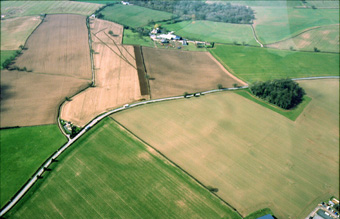Ironworking seems to have been distributed through the area in the decades preceding the Roman occupation, notably at Ariconium which would develop into a
Romano-British industrial town.
Ariconium is 10km south east from Hentland and was the largest settlement in the area in the late iron age and
Romano-British periods. Coins found at Ariconium include those of the Atrabates - in modern Hampshire, West Sussex and
Berkshire - centred on Calleva Atrebatum (Silchester); the Corieltauvi (formerly thought to be called the
Coritani) who occupied the East Midlands: and the
Trinovantes - from modern Essex and Suffolk, with their capital at
Camelodunum; the Catauvelauni, who occupied Hertfordshire, Bedfordshire and southern Cambridgeshire. The largest number of
coins are Dobunnic. The Dobunni were incorporated into the Roman Empire in about AD 43, even before Romans reached
their territory.
To the West the Silures, in modern south Wales, were more
resistant to Roman influence. In the winter of AD 47/48
Caratacus (formerly spelled Caractacus) a Catuvellauni chieftain,
who moved west to continue opposing Rome, led the Silures in an attack on a neighbouring pro-Roman tribe,
which is presumed to have been the Dobunni.
In response, Publius Ostorius Scapula, the second Roman governor, occupied the territory to the north-west of the original limit of Roman Britain on the Fosse Way to occupy a large area
which is now the West Midlands and the Marches.
The area which would have included Hentland. Although the Silures were defeated, it wasn't until 78 AD, 35 years after the
beginning of Roman occupation in the east, that campaigns against them came to an end.

The ploughed-out Gaer Cop Iron Age hill-fort in Hentland parish. The ditch is visible as a darker green
against the lighter green of the rest of the crop in the two fields in the foreground.
A lighter mark beyond indicates the position of the internal bank. The bank has dictated the course of the old lane
running into the distance. The larger road is a turnpike newly built in the 1820s which cut through the
then standing ramparts of the hillfort.
Several sites of the period were investigated during the construction of a pipeline through the area.
At Winter's Cross on the A49, not far from Gillow there was a Romano-British enclosure at the base of a hill,
boundary ditches on the slope and furnaces on the crest.
